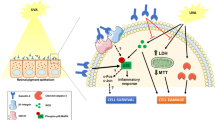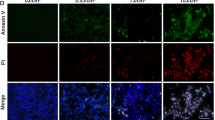Abstract
The retina is constantly exposed to ultraviolet (UV) light with different wavelengths, which may lead to chronic UV-induced retinal injury. In our previous studies, we have shown the protective effects of pituitary adenylate cyclase activating polypeptide (PACAP) in toxic and ischemic retinal injuries. The aim of the present study was to investigate the effects of PACAP in UV-A-induced retinal lesion. We used diffuse UV-A radiation (315–400 nm) to induce acute retinal damage over a short period of exposure. Using standard histological (morphological and morphometrical) analysis, we assessed the actions of intravitreal PACAP (100 pmol/5 µl) treatment on acute UV-A-induced retinal damage. We measured the thickness of nuclear and plexiform layers as well as the number of cells in the outer nuclear and inner nuclear layers and in the ganglion cell layer. Outer limiting membrane–inner limiting membrane distances in the cross-section of the retina were also examined. Our results show that UV-A light-induced retinal damage led to severe degeneration in the photoreceptor layer, and in the outer and inner nuclear layers. Alteration in the plexiform layers was also observed. We found that post-irradiation PACAP treatment significantly attenuated the UV-A-induced retinal damage. Our results provide the basis for future clinical application of PACAP treatment in retinal degeneration and may have clinical implications in several ophthalmic diseases.


Similar content being viewed by others
References
Andley UP, Lewis RM, Reddan JR, Kochevar IE (1994) Action spectrum for cytotoxicity in the UVA- and UVB-wavelength region in cultured lens epithelial cells. Invest Ophthalmol Vis Sci 35:367–373
Arimura A (2007) PACAP: the road to discovery. Peptides 28:1617–1619
Atlasz T, Babai N, Kiss P et al (2007) Pituitary adenylate cyclase activating polypeptide is protective in bilateral carotid occlusion-induced retinal lesion in rats. Gen Comp Endocrinol 153:108–114
Atlasz T, Szabadfi K, Kiss P et al (2008) PACAP-mediated neuroprotection of neurochemically identified cell types in MSG-induced retinal regeneration. J Mol Neurosci 36:97–104
Atlasz T, Szabadfi K, Reglodi D et al (2009) Effects of pituitary adenylate cyclase activating polypeptide (PACAP1–38) and its fragments on retinal degeneration induced by neonatal MSG treatment. Ann NY Acad Sci 1163:348–352
Atlasz T, Szabadfi K, Kiss P et al (2010a) Evaluation of the protective effects of PACAP with cell-specific markers in ischemia-induced retinal degeneration. Brain Res Bull 81:497–504
Atlasz T, Szabadfi K, Kiss P et al (2010b) Review of pituitary adenylate cyclase activating polypeptide in the retina: focus on the retinoprotective effects. Ann NY Acad Sci, in press
Babai N, Atlasz T, Tamas A, Reglodi D, Kiss P, Gabriel R (2005) Degree of damage compensation by various PACAP treatments in monosodium glutamate-induced retina degeneration. Neurotox Res 8:227–233
Babai N, Atlasz T, Tamas A et al (2006) Search for the optimal monosodium glutamate treatment schedule to study the neuroprotective effects of PACAP in the retina. Ann NY Acad Sci 1070:149–155
Buschke W, Friedenwald JS, Moses SG (1945) Effects of ultraviolet irradiation on corneal epithelium: mitosis, nuclear fragmentation, post-traumatic cell movements, loss of tissue cohesion. J Comp Physiol 26:147–164
Correia O, Delgado L, Barros MA (1994) Bullous photodermatosis after lomefloxacin. Arch Dermatol 130:808–809
D’Agata V, Cavallaro S (1998) Functional and molecular expression of PACAP/VIP receptors in the rat retina. Mol Brain Res 54:161–164
Dillon J (1991) The photophysics and photobiology of the eye. J Photochem Photobiol 10:23–40
Halliwell B, Aruoma OI, Wasil M, Gutteridge JM (1988) The resistance of transferrin, lactoferrin and caeruloplasmin to oxidative damage. Biochem J 256:311–312
Hannibal J, Fahrenkrug J (2004) Target areas innervated by PACAP immunoreactive retinal ganglion cells. Cell Tissue Res 316:99–113
Hightower K, McCready J (1992) Mechanisms involved in cataract development following near-ultraviolet radiation of cultured lenses. Curr Eye Res 11:679–689
Izumi S, Seki T, Shioda S, Zhou CJ, Arimura A, Koide R (2000) Ultrastructural localization of PACAP immunoreactivity in the rat retina. Ann NY Acad Sci 921:317–320
Jose JG (1986) Posterior cataract induction by UV-B radiation in albino mice. Exp Eye Res 42:11–20
Kiss P, Szogyi D, Reglodi D et al (2009) Effects of perinatal asphyxia on the neurobehavioral and retinal development of newborn rats. Brain Res 1255:42–50
Kleiman NJ, Wang RR, Spector A (1990) Ultraviolet light induced DNA damage and repair in bovine lens epithelial cells. Curr Eye Res 9:1185–1193
Kubrusly RC, da Cunha MC, Reis R et al (2005) Expression of functional receptors and transmitter enzymes in cultured Muller cells. Brain Res 1038:141–149
Miyata A, Arimura A, Dahl RR et al (1989) Isolation of a novel 38 residue-hypothalamic polypeptide which stimulates adenylate cyclase in pituitary cells. Biochem Biophys Res Commun 164:567–574
Nakamachi T, Ohtaki H, Yofu S et al (2010) Endogenous pituitary adenylate cyclase activating polypeptide is involved in suppression of edema in the ischemic brain. Acta Neurochir Suppl 106:43–46
Nakatani M, Seki T, Shinohara Y et al (2006) Pituitary adenylate cyclase activating polypeptide (PACAP) stimulates production of interleukin-6 in rat Muller cells. Peptides 27:1871–1876
Ohtaki H, Nakamachi T, Dohi K et al (2006) Pituitary adenylate cyclase-activating polypeptide (PACAP) decreases ischemic neuronal cell death in association with IL-6. Proc Natl Acad Sci U S A 103:7488–7493
Penn JS, Naash MI, Anderson RE (1987) Effect of light history on retinal antioxidants and light damage susceptibility in the rat. Exp Eye Res 44:779–788
Rabl K, Reglodi D, Banvolgyi T et al (2002) PACAP inhibits anoxia-induced changes in physiological responses in horizontal cells in the turtle retina. Regul Pept 109:71–74
Racz B, Gallyas F Jr, Kiss P et al (2006) The neuroprotective effects of PACAP in monosodium glutamate-induced retinal lesion involve inhibition of proapoptotic signaling pathways. Regul Pept 137:20–26
Racz B, Gallyas F Jr, Kiss P et al (2007) Effects of pituitary adenylate cyclase activating polypeptide (PACAP) on the PKA-Bad-14-3-3 signaling pathway in glutamate-induced retinal injury in neonatal rats. Neurotox Res 12:95–104
Reglodi D, Tamas A, Somogyvari-Vigh A et al (2002) Effects of pretreatment with PACAP on the infarct size and functional outcome in rat permanent focal cerebral ischemia. Peptides 23:2227–2234
Rosen JE, Chen D, Prahalad AK, Spratt TE, Schluter G, Williams GM (1997) A fluoroquinolone antibiotic with a methoxy group at the 8 position yields reduced generation of 8-oxo-7, 8-dihydro-2′-deoxyguanosine after ultraviolet-A irradiation. Toxicol Appl Pharmacol 145:381–387
Schein OD (1992) Phototoxicity and the cornea. J Natl Med Assoc 84:579–583
Seki T, Shioda S, Ogino D, Nakai Y, Arimura A, Koide R (1997) Distribution and ultrastructural localization of a receptor for pituitary adenylate cyclase activating polypeptide and its mRNA in the rat retina. Neurosci Lett 238:127–130
Seki T, Izumi S, Shioda S, Zhou CJ, Arimura A, Koide R (2000a) Gene expression for PACAP receptor mRNA in the rat retina by in situ hybridization and in situ RT-PCR. Ann NY Acad Sci 921:366–369
Seki T, Shioda S, Izumi S, Arimura A, Koide R (2000b) Electron microscopic observation of pituitary adenylate cyclase activating polypeptide (PACAP)-containing neurons in the rat retina. Peptides 21:109–113
Seki T, Nakatani M, Taki C et al (2006) Neuroprotective effect of PACAP against kainic acid-induced neurotoxicity in rat retina. Ann NY Acad Sci 1070:531–534
Seki T, Itoh H, Nakamachi T, Shioda S (2008) Suppression of ganglion cell death by PACAP following optic nerve transection in the rat. J Mol Neurosci 36:57–60
Shoge K, Mishima HK, Saitoh T et al (1999) Attenuation by PACAP of glutamate-induced neurotoxicity in cultured retinal neurons. Brain Res 839:66–73
Silveira MS, Costa MR, Bozza M, Linden R (2002) Pituitary adenylyl cyclase-activating polypeptide prevents induced cell death in retinal tissue through activation of cyclic AMP-dependent protein kinase. J Biol Chem 277:16075–16080
Somogyvari-Vigh A, Reglodi D (2004) Pituitary adenylate cyclase activating polypeptide: a potential neuroprotective peptide—review. Curr Pharm Des 10:2861–2889
Szabadfi K, Mester L, Reglodi D et al. (2010) Novel neuroprotective strategies in ischemic retinal lesions. Int J Mol Sci 11:544–561
Tamas A, Gabriel R, Racz B et al (2004) Effects of pituitary adenylate cyclase activating polypeptide in retinal degeneration induced by monosodium-glutamate. Neurosci Lett 372:110–113
Tanito M, Kaidzu S, Ohira A, Anderson RE (2008) Topography of retinal damage in light-exposed albino rats. Exp Eye Res 87:292–295
Tuncel N, Basmak H, Uzuner K et al (1996) Protection of rat retina from ischemia–reperfusion injury by vasoactive intestinal peptide (VIP): the effect of VIP on lipid peroxidation and antioxidant enzyme activity of retina and choroid. Ann NY Acad Sci 805:489–498
Uchida D, Tatsuno I, Tanaka T et al (1998) Maxadilan is a specific agonist and its deleted peptide (M65) is a specific antagonist for PACAP type 1 receptor. Ann NY Acad Sci 865:253–258
Vaudry D, Falluel-Morel A, Bourgault S et al (2009) Pituitary adenylate cyclase-activating polypeptide and its receptors: 20 years after the discovery. Pharmacol Rev 61:283–357
Verna LK, Chen D, Schluter G, Williams GM (1998) Inhibition by singlet oxygen quenchers of oxidative damage to DNA produced in cultured cells by exposure to a quinolone antibiotic and ultraviolet A irradiation. Cell Biol Toxicol 14:237–242
Waschek JA (2002) Multiple actions of pituitary adenylyl cyclase activating peptide in nervous system development and regeneration. Dev Neurosci 24:14–23
Weiter JJ (1987) Phototoxic changes in the retina. In: Miller D (ed) Clinical light damage to the eye. Springer, New York, pp 79–125
Winkler BS, Giblin FJ (1983) Glutathione oxidation in retina: effects on biochemical and electrical activities. Exp Eye Res 36:287–297
Woodford BJ, Tso MO, Lam KW (1983) Reduced and oxidized ascorbates in guinea pig retina under normal and light-exposed conditions. Invest Ophthalmol Vis Sci 24:862–867
Zrenner E (1990) Light-induced damage to the eye. Fortschr Ophthalmol 87:41–51, Review
Acknowledgments
Hungarian National Scientific Grants OTKA T061766, K72592, F67830, CNK 78480, ETT278-04/2009, Richter Gedeon Centenary Foundation, Bolyai Scholarship, University of Pecs Medical School Research Grant 2009.
Author information
Authors and Affiliations
Corresponding author
Additional information
T. Atlasz, K. Szabadfi, D. Reglodi, and R. Gabriel contributed equally to the present work.
Rights and permissions
About this article
Cite this article
Atlasz, T., Szabadfi, K., Kiss, P. et al. Effects of PACAP in UV-A Radiation-Induced Retinal Degeneration Models in Rats. J Mol Neurosci 43, 51–57 (2011). https://doi.org/10.1007/s12031-010-9392-3
Received:
Accepted:
Published:
Issue Date:
DOI: https://doi.org/10.1007/s12031-010-9392-3




